Windows Update is a very useful service that provides a platform for updating the operating system. It helps to ensure that your device is running with the latest features and security updates. However, some users have recently encountered error code 0x8024a203 when they run the Windows Update on their computers. In this post, we have covered some quick and easy solutions that could help you resolve this issue. Now, let’s find out how to resolve it.
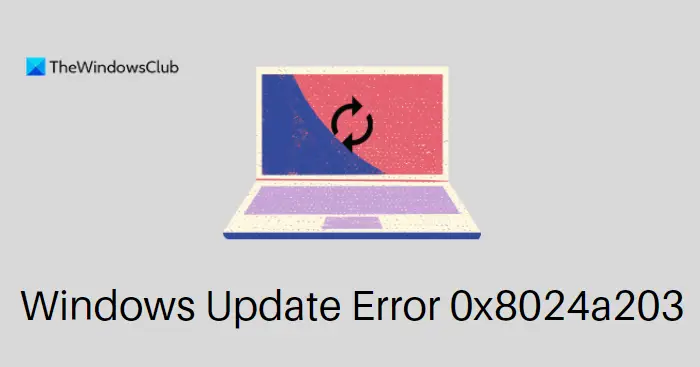
Fix Windows Update Error 0x8024a203 on Windows 11/10
Despite the newness of the Windows operating system, users are experiencing multiple problems with it. One of these errors is 0x8024a203, which occurs during the updating of Windows. At this point, the user is unable to download and install the latest Windows update. In case you’re facing the same problem as us, do not worry, we’ve come up with a list of effective solutions to help you with it.
- Run Windows Update Troubleshooter
- Delete the Temporary Files
- Run SFC and DISM tool
- Reset Windows Update Components
- Manually download and install updates
Let’s now see them in detail.
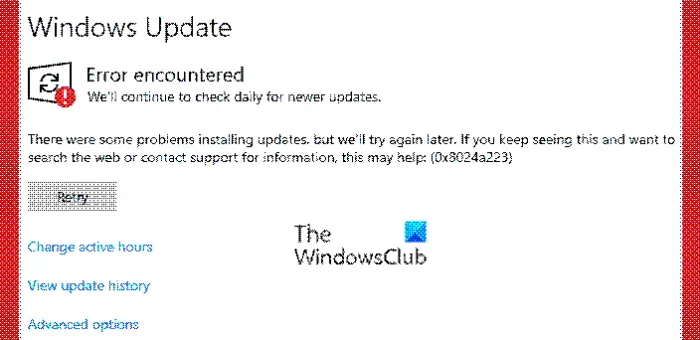
1] Run Windows Update Troubleshooter
Microsoft Windows comes with various types of troubleshooting tools that can be used to fix various kinds of problems. When you encounter a Windows Update error, you should run the Windows Update troubleshooter first. You can do this by following these steps:
For Windows 11
- Open the Windows Settings. For quick access to the Settings app, use the Windows+I keyboard shortcut.
- On the left side of the screen select System.
- Then scroll down and click the Troubleshooting section.
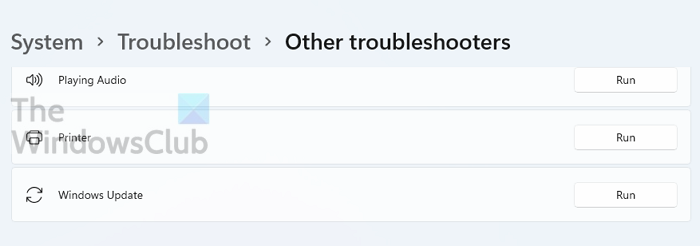
- Click the Run button next to Windows Update.
- When the troubleshooting process is complete, the problem might be resolved.
For Windows 10
- Launch the Windows Settings.
- Click on the Update & Security category.
- From the left pane, click on the Troubleshoot tab.
- Then click on the Additional troubleshooter link.
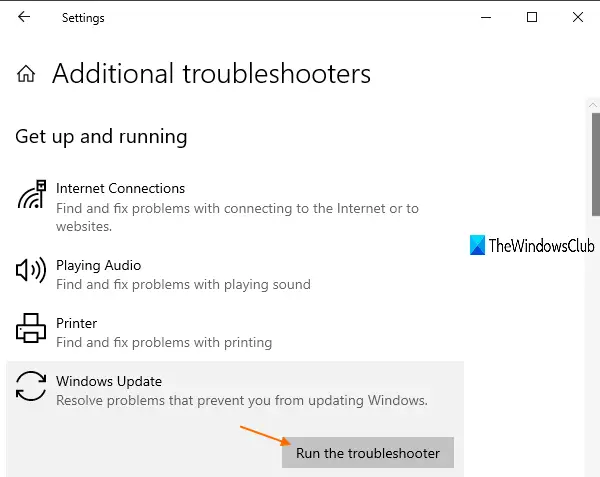
- On the next page, select Windows Update and click Run the troubleshooter.
- Once you have done this, check if the issue persists.
2] Delete the Temporary Files
If you experience trouble installing Windows updates, you can clear your temporary files and cache. After clearing them, restart your computer and check if it works.
3] Run SFC and DISM
The System File Checker (SFC) is a tool that users can use to detect and restore corrupt system files. If you’re experiencing this problem, it seems some of the files needed for Windows Update are damaged, altered, or missing. In order to restore missing or corrupt system files, you can use System File Checker, followed by Deployment Image Servicing and Management (DISM).
Follow the below instructions to run SFC and DISM:
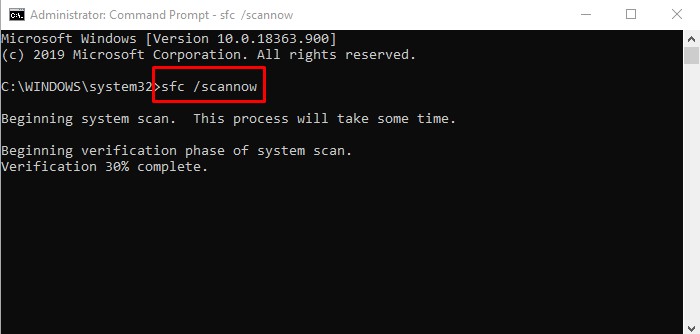
Run the Command Prompt as an administrator.
Type in sfc /scannow and press Enter.
Wait a few minutes for the procedure to complete. While the system is scanning the code, you can perform any other task you wish.
Once it completes the scanning process, restart your computer to see if it works.
If that doesn’t resolve the problem, run DISM to repair the corrupted Windows Update files.
Copy and paste the following command into the elevated Command Prompt window and press the Enter key:
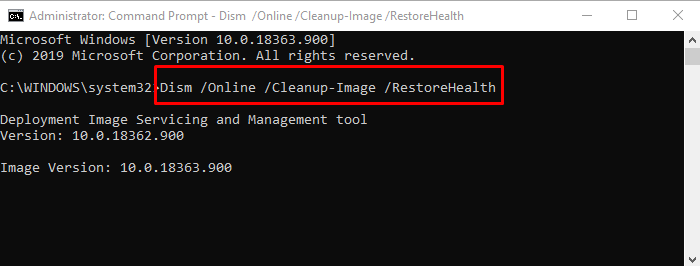
DISM.exe /Online /Cleanup-image /Restorehealth
Once this is done, restart your computer and the problem should be resolved.
However, if your Windows Update client is already broken, you will be prompted to use a running Windows installation as the repair source or use a Windows side-by-side folder from a network share, as the source of the files.
You will then be required to run the following command instead:
DISM.exe /Online /Cleanup-Image /RestoreHealth /Source:C:\RepairSource\Windows /LimitAccess
Here you have to replace the C:\RepairSource\Windows placeholder with the location of your repair source.
Once the process is complete, DISM will create a log file in %windir%/Logs/CBS/CBS.log and capture any issues that the tool finds or fixes.
Close the command prompt, and then run Windows Update again and see it has helped.
4] Reset Windows Update Components
This problem can also happen if some type of corruption occurs in your system files. Hence, if you are still experiencing a problem after running the SFC and DISM utilities, you can reset the Windows Update Components and see if it works. Here is a guide to help you do this:
- The first thing you need to do is run the Command Prompt as an administrator.
- To do so, press the Windows key + R to open the Run dialog box.
- In the text field, type in cmd and press Ctrl+Shift+Enter keyboard shortcut.
- When UAC asks for permission, click Yes.
- Once it opens the Command Prompt, type the following commands. After typing each command, press Enter:
net stop bits net stop wuauserv net stop appidsvc net stop cryptsvc
- In this case, the Background Intelligent Transfer Service (BITS), Windows Update service, and Cryptographic service will stop working.
- It is now time to reset Windows Update components by deleting all qmgr*.dat files from your computer.
- To do this, type the below command line in the command prompt and hit enter.
Del "%ALLUSERSPROFILE%\Application Data\Microsoft\Network\Downloader\qmgr*.dat"
- Afterward, type Y on your keyboard to confirm the deletion.
- Next, you should rename the SoftwareDistribution and catroot2 folders.
- To do this, run the following commands in the command prompt window. Don’t forget to press Enter after typing each command.
Ren %systemroot%\SoftwareDistribution SoftwareDistribution.bak Ren %systemroot%\system32\catroot2 catroot2.bak
- After you have done this, you need to reset both BITS and Windows Update services to their default settings.
- To do this, type the below commands in the elevated command prompt window:
sc.exe sdset bits D:(A;;CCLCSWRPWPDTLOCRRC;;;SY)(A;;CCDCLCSWRPWPDTLOCRSDRCWDWO;;;BA)(A;;CCLCSWLOCRRC;;;AU)(A;;CCLCSWRPWPDTLOCRRC;;;PU) sc.exe sdset wuauserv D:(A;;CCLCSWRPWPDTLOCRRC;;;SY)(A;;CCDCLCSWRPWPDTLOCRSDRCWDWO;;;BA)(A;;CCLCSWLOCRRC;;;AU)(A;;CCLCSWRPWPDTLOCRRC;;;PU)
- To execute the commands, press Enter after each one.
- In the command prompt window, type the following code to move to the System32 directory. Press Enter to continue.
cd /d %windir%\system32
- Type the following commands, and be sure to hit enter after each command.
regsvr32.exe atl.dll regsvr32.exe urlmon.dll regsvr32.exe mshtml.dll regsvr32.exe shdocvw.dll regsvr32.exe browseui.dll regsvr32.exe jscript.dll regsvr32.exe vbscript.dll regsvr32.exe scrrun.dll regsvr32.exe msxml.dll regsvr32.exe msxml3.dll regsvr32.exe msxml6.dll regsvr32.exe actxprxy.dll regsvr32.exe softpub.dll regsvr32.exe wintrust.dll regsvr32.exe dssenh.dll regsvr32.exe rsaenh.dll regsvr32.exe gpkcsp.dll regsvr32.exe sccbase.dll regsvr32.exe slbcsp.dll regsvr32.exe cryptdlg.dll regsvr32.exe oleaut32.dll regsvr32.exe ole32.dll regsvr32.exe shell32.dll regsvr32.exe initpki.dll regsvr32.exe wuapi.dll regsvr32.exe wuaueng.dll regsvr32.exe wuaueng1.dll regsvr32.exe wucltui.dll regsvr32.exe wups.dll regsvr32.exe wups2.dll regsvr32.exe wuweb.dll regsvr32.exe qmgr.dll regsvr32.exe qmgrprxy.dll regsvr32.exe wucltux.dll regsvr32.exe muweb.dll regsvr32.exe wuwebv.dll
- Running the above commands will re-register all the respective BITS files and Windows Update related DLL files
- Your next step should be to reset the network configurations that may have contributed to the problematic error.
- In order to do that, run the below commands:
netsh winsock reset netsh winsock reset proxy
- After you have done this, it’s time to restart the services you stopped earlier, such as Background Intelligent Transfer Service (BITS), Windows Update, and Cryptography.
- For this, open the Command Prompt and run the below command line. You must press Enter after each command.
net start bits net start wuauserv net start appidsvc net start cryptsvc
- Now close the Command Prompt window and restart your computer.
- When your PC starts, go to Windows Updates and see if you can install the pending updates
5] Manually download and install updates
When none of the above solutions resolve the problem, you can try downloading and installing the update manually from the Microsoft Update Catalog and see if that helps.
How do I fix the Windows Update assistant error?
In case you’re having issues with Windows Update Assistant on your computer, you can use the following steps to fix the issue. Restart the Windows Update Service. Run the Windows Update troubleshooter. Temporarily turn off the Third-Party Antivirus program and Windows Defender. Clean up the update cache.
What does Windows Update do?
Windows Update keeps the operating system and other Microsoft programs updated. The security patches and feature upgrades provided by Microsoft prevent malware attacks and other threats. Furthermore, it allows you to view your update history, which lists all the updates that your computer has downloaded and installed.
Related: Fix Windows Update Error 0x80242014.